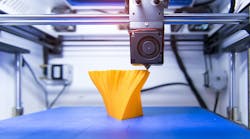Project Aims to Create a Fully Automated 3D Printing Production in One System
3D printing is a digital manufacturing technology, meaning that a large part of the production process is managed online. However, finishing the printed components still has some manual process steps.
The Danish company Scape Technologies, Danish Technological Institute, and the UK company AMT will collaborate in the field and try to automate these in a new EU-supported project.
The Process of Additive Manufacturing for Creating 3D Objects
Additive manufacturing is the process of creating a 3D object by building it one layer at a time and using CAD software or 3D object scanners to direct hardware to deposit material, layer upon layer, in precise geometric shapes. As its name implies, additive manufacturing adds material to create an object.
Although the terms "3D printing" and "rapid prototyping" are casually used to discuss additive manufacturing, each process is a subset of additive manufacturing. Currently, the industry uses post-processing methods that are labor-intensive, dusty, energy-inefficient, and environment-polluting. The latter is especially problematic as current smoothing methods produce micro-fiber plastic polluted water as a by-product. These are mechanical-contact-based methods that remove material from the parts, resulting in loss of accuracy, fine features, and degradation of part properties while leaving surfaces porous and non-sealed. As a result, opportunities abound for automating the complete process in one system.
Industrial 3D Printing Production, Handling, and Finishing Done in One Automated System
Over the past years, the Danish Technological Institute (DTI) in Aarhus, Denmark has established a complete setup for industrial 3D printing production in both metal and plastic. This setup includes both the digital processes that precede the printing, the 3D printing process itself, and the finishing steps that finalize the printed parts. Precisely the finishing of the printed parts is something that primarily requires manual handling.
"When printing in plastic powder—or Selective Laser Sintering technology—this means that the parts are taken out of the build chamber when it has cooled down so that most of the powder can be removed. The parts are then blasted clean of the remaining powder, and in the case of parts where hygiene and ease-of-cleaning are important, e.g. parts for food contact, they also get a surface sealing. All these processes require manual handling", says Anders Bæk Hjermitslev, Team Manager at the Danish Technological Institute.
Now, DTI will try to automate these processes in a new EU-supported project called DMS Nextgen. The project will develop a system that can take the entire 3D printed build job immediately after the printing process and do all the finishing, i.e. cooling and unpacking, blasting the parts, and finally sealing the surface. For this system, the plan is to use a conveyor bay and robots to move the parts between the various process steps.
The project is done in collaboration with the Danish software automation company Scape Technologies, which is a specialist in robotic automated material handling—known as bin-picking. In this project, Scape Technologies will provide visual recognition, gripping techniques, and robot path planning development to transport the 3D printed objects between the modules of the de-powdering machine, the smoothing machine, and the final stage of object inspection and sorting.
”Automating the post-processing of 3D printed objects poses some very interesting challenges, even with the experience and technology already available at Scape. One primary concern is the accurate identification of an object and its orientation, within a batch of objects that might have differing designs and with the object still not being detailed due to the residuals left by the printing process. These elements combine to a higher degree of variance in the objects than accustomed and will challenge the recognition process in ways different than we are normally confronted with. Secondarily the actual grip and handling of the diversity of objects within a single batch requires consideration when usual targets with respect to precision and speed are to be upheld”, says Carl Johan Danbjørg, Development Project Manager at Scape Technologies.
The UK – Sheffield based company Additive Manufacturing Technologies (AMT) will make equipment for post-processing of 3D printed parts.
At the end of the project, the entire system will be integrated, and the demo system developed in the project will subsequently be placed at the DTI.
About DMS Nextgen Project
DMS Nextgen is a Eurostars project with a total budget of just under EUR 1.1 million. Eurostars is part of the Eureka network which is co-funded by the European Union through Horizon Europe–In Denmark, the project is funded by the Danish Innovation Fund.
The project runs from January 2024 to September 2025. The project partners are the Danish Technological Institute, AMT, and Scape Technologies A/S.
Scape Technologies, founded in 2004, is a focused robotics enterprise that has developed a unique and patented technology to recognize, pick, and place parts. Scape Technologies offers a complete solution with fully integrated components and software modules that together create a coherent and efficient solution that can be connected directly to the leading six-axis robot brands used in the industry such as Universal Robots, ABB, Fanuc, Yaskawa, KUKA, and more.










